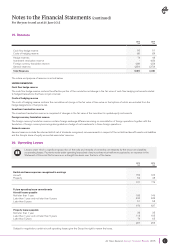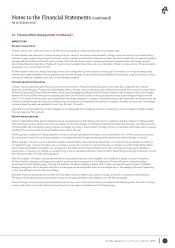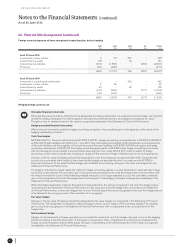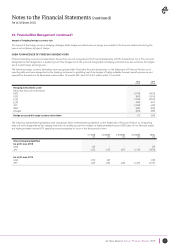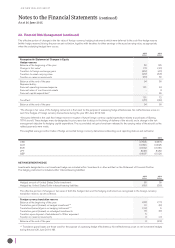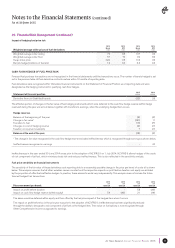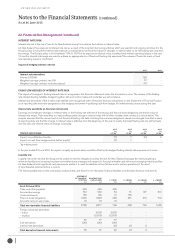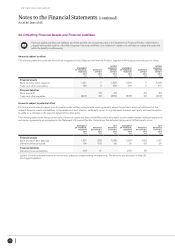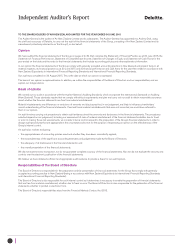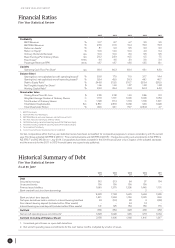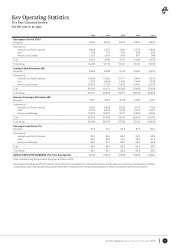Air New Zealand 2015 Annual Report Download - page 39
Download and view the complete annual report
Please find page 39 of the 2015 Air New Zealand annual report below. You can navigate through the pages in the report by either clicking on the pages listed below, or by using the keyword search tool below to find specific information within the annual report.
Notes to the Financial Statements (continued)
As at 30 June 2015
Air New Zealand Annual Financial Results 2015 37
23. Financial Risk Management (continued)
STATEMENT
OF FINANCIAL
POSITION
$M
CONTRACTUAL
CASH FLOWS
$M
< 1 YEAR
$M
1-2 YEARS
$M
2-5 YEARS
$M
5+ YEARS
$M
As at 30 June 2014
Trade and other payables
Secured borrowings
Unsecured bonds
Finance lease obligations
398
213
150
1,370
398
236
176
1,516
398
26
10
191
-
40
10
195
-
56
156
539
-
114
-
591
Total non-derivative financial liabilities 2,131 2,326 625 245 751 705
Foreign exchange derivatives
– Inflow
– Outflow
2,460
(2,518)
2,435
(2,492)
25
(26)
-
-
-
-
Fuel derivatives
(53)
25
(58)
21
(57)
21
(1)
-
-
-
-
-
Total derivative financial instruments (28) (37) (36) (1) - -
Fair value estimation
All financial instruments for which fair value is recognised or disclosed are categorised within the fair value hierarchy as described
below. All financial instruments are either carried at fair value or amounts approximating fair value, with the exception of interest-
bearing liabilities, for which the fair value is disclosed in Note 14 Interest-bearing liabilities. This equates to “Level 2” of the fair
value hierarchy defined within NZ IFRS 13 – Fair Value Measurement. The fair value of the investment in quoted equity instruments
(Note 11) is determined by reference to quoted market prices in an active market (“Level 1” of the fair value hierarchy). The fair value
of derivative financial instruments is based on published market prices for similar assets or liabilities or market observable inputs to
valuation at balance date (“Level 2” of the fair value hierarchy). The fair value of foreign currency forward contracts is determined
using forward exchange rates at reporting date. The fair value of fuel swap and option agreements is determined using forward fuel
prices at reporting date. The fair value of interest rate swaps is determined using forward interest rates as at reporting date.
Capital risk management
The Group’s objectives when managing capital are to safeguard the company’s ability to continue as a going concern and to continue to generate
shareholder value and benefits for other stakeholders, and to provide an acceptable return for shareholders by removing complexity, reducing costs
and pricing our services commensurately with the level of risk. The Group is not subject to any externally imposed capital requirements.
The Group’s capital structure is managed in the light of economic conditions, future capital expenditure profiles and the risk characteristics of the
underlying assets. The Group’s capital structure may be modified by adjusting the amount of dividends paid to shareholders, initiating dividend
reinvestment opportunities, returning capital to shareholders, issuing new shares or selling assets to reduce debt. The capital management policies
and guidelines are regularly reviewed by the Board of Directors.
The Group monitors capital on the basis of gearing ratios. These ratios are calculated as net debt (both including and excluding capitalised operating
leases) over net debt plus equity. Net debt is calculated as total borrowings, bonds and finance lease obligations (including net open derivatives on
these instruments) less cash and cash equivalents, non interest-bearing assets and interest-bearing assets. Capital comprises all components of
equity. These ratios and their calculation are disclosed in the Five Year Statistical Review.


